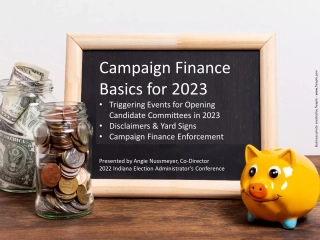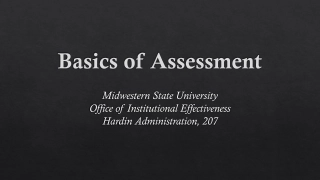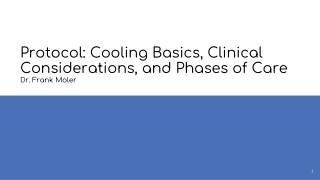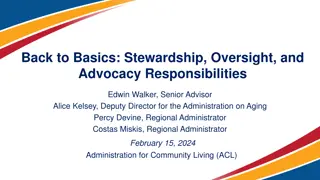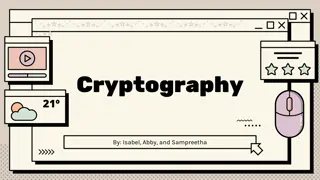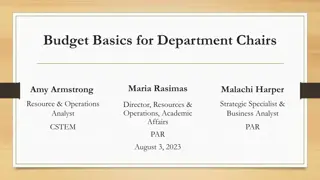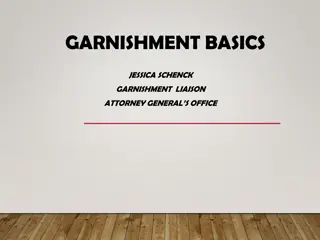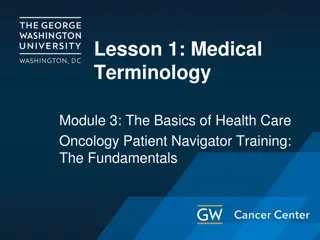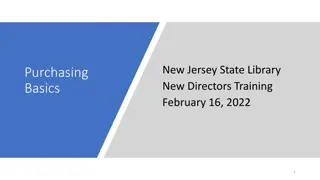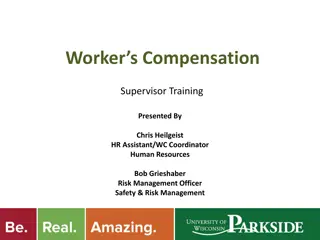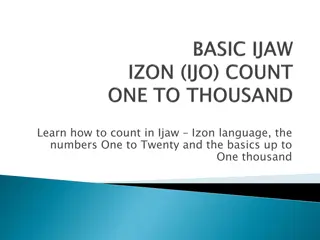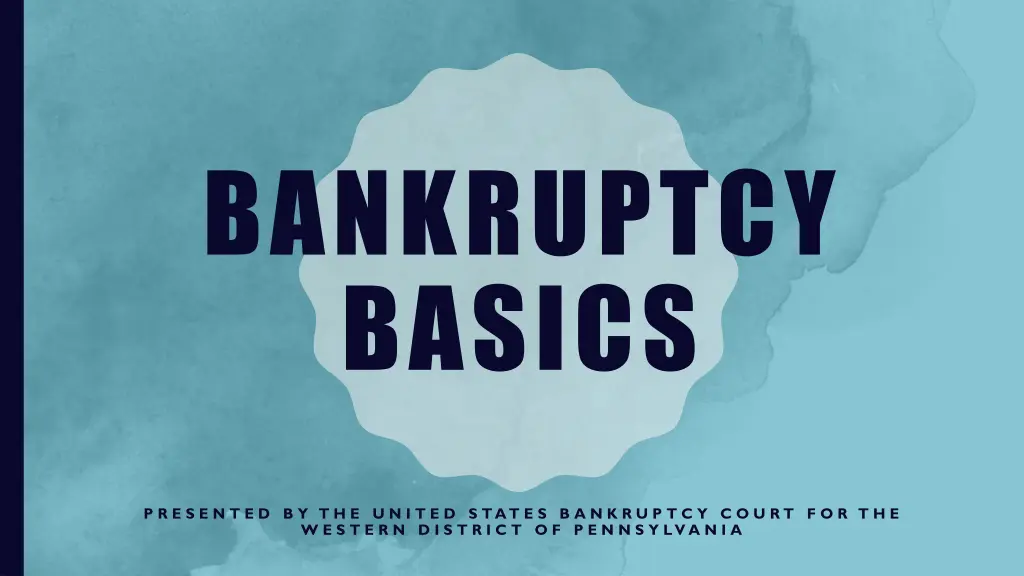
Understanding Bankruptcy Basics and History in the United States
Learn about the basics of bankruptcy, its key players, the history of bankruptcy laws in the United States from the early years to modern times, and how bankruptcy provides a fresh start for debtors. Explore the roles of debtors, creditors, bankruptcy courts, trustees, and the evolution of bankruptcy laws through significant acts such as the Bankruptcy Act of 1898 and the Bankruptcy Reform Act of 1978.
Download Presentation

Please find below an Image/Link to download the presentation.
The content on the website is provided AS IS for your information and personal use only. It may not be sold, licensed, or shared on other websites without obtaining consent from the author. If you encounter any issues during the download, it is possible that the publisher has removed the file from their server.
You are allowed to download the files provided on this website for personal or commercial use, subject to the condition that they are used lawfully. All files are the property of their respective owners.
The content on the website is provided AS IS for your information and personal use only. It may not be sold, licensed, or shared on other websites without obtaining consent from the author.
E N D
Presentation Transcript
BANKRUPTCY BASICS P R E S E N T E D B Y T H E U N I T E D S TAT E S B A N K R U P T C Y C O U R T F O R T H E W E S T E R N D I S T R I C T O F P E N N S Y LV A N I A
Definition: A legal process that provides individuals and businesses facing insurmountable debt with a fresh start or a way to reorganize their finances. Goal: To balance the interests of debtors and creditors fairly. Key Players: WHAT IS BANKRUPTCY? Debtor: The individual or entity filing for bankruptcy. Creditor: Those to whom the debtor owes money. Bankruptcy Court: Oversees the bankruptcy process. Trustee: Oversees the debtor's case.
HISTORY OF BANKRUPTCY IN THE UNITED STATES The Early Years of Bankruptcy Law in the United States The U.S. Constitution (Article I, Section 8) grants Congress the power to establish uniform bankruptcy laws. This authority aimed to address conflicting state laws and protect creditors, particularly those involved in interstate commerce. Early bankruptcy acts (1800, 1841, 1867) were short-lived, reflecting differing regional perspectives on bankruptcy and leading to a cycle of enactment and repeal.
HISTORY OF BANKRUPTCY IN THE UNITED STATES (CONTINUED) The Path to Modern Bankruptcy Law The Bankruptcy Act of 1898, responding to the growing national economy, established a more enduring framework for bankruptcy. This act, considered pro-debtor, introduced the role of referees, later known as bankruptcy judges, to oversee cases. The 1978 Bankruptcy Reform Act brought significant changes, established bankruptcy courts in each district and allows for separate bankruptcy judges along with creating a new Chapter 11 and 13. Later reforms, such as the 1994 and 2005 acts, aimed to address issues like abuse, creditor protection, and debtor accountability.
Bankruptcy's central purpose is providing a "fresh start" for debtors struggling with unmanageable debt. Here's a breakdown of how bankruptcy helps achieve a fresh start: Discharge of Debts: Bankruptcy can discharge various debts, meaning the debtor is no longer personally liable for repayment. This release offers a clean slate to rebuild finances. Protection from Creditors: Filing a bankruptcy petition triggers an "automatic stay," which immediately halts most collection actions by creditors. This protection provides breathing room for the debtor to address their financial situation without harassment. Debt Restructuring: Chapters 11 and 13 allow debtors to propose plans for reorganizing their finances and repaying debts within their means. This process can modify loan terms, reduce debt amounts, or establish a manageable payment schedule. WHY FILE FOR BANKRUPTCY The ability to discharge debts and obtain a fresh start is a core principle underlying bankruptcy filings, particularly in Chapters 7 and 13.
CHAPTERS OF BANKRUPTCY The U.S. Bankruptcy Code outlines different chapters for various situations: Chapter 7: Liquidation Chapter 9: Municipal Bankruptcy* Chapter 11: Reorganization Chapter 12: Family Farmers and Fishermen Chapter 13: Individual Debt Adjustment Chapter 15: Cross-Border Insolvency *Municipal Bankruptcy is rare and not discussed in this presentation
CHAPTER 7 BANKRUPTCY: LIQUIDATION Designed For: Individuals and businesses unable to pay their debts. Process: Debtor sells non-exempt assets to repay creditors. Remaining eligible debts are discharged.
CHAPTER 11 BANKRUPTCY: REORGANIZATION Designed For: Businesses and some individuals seeking to restructure their finances. Process: Debtor proposes a plan to repay debts over time. Creditors vote on the plan, and court approval is required. Allows the debtor to continue operating.
CHAPTER 12 BANKRUPTCY: FAMILY FARMERS AND FISHERMEN Designed For: Family farmers and fishermen with regular income facing financial distress. Process: Debtor proposes a repayment plan to be completed within three to five years. Plan must be approved by the court.
CHAPTER 13 BANKRUPTCY: INDIVIDUAL DEBT ADJUSTMENT Designed For: Individuals with regular income who want to reorganize their debt. Process: Debtor proposes a plan to repay debts over three to five years. Creditors are repaid through the bankruptcy court.
CHAPTER 15 BANKRUPTCY: CROSS- BORDER INSOLVENCY Designed For: Handling international bankruptcy cases. Process: Facilitates cooperation between U.S. courts and foreign courts. Ensures fair treatment of debtors and creditors across borders.
MAJOR DIFFERENCES BETWEEN CHAPTER 7, 11, AND 13 BANKRUPTCY Chapter 7 Bankruptcy (Liquidation): This chapter focuses on liquidating a debtor's non-exempt assets to repay creditors. It is available to individuals, partnerships, corporations, or other business entities. Individual debtors typically receive a discharge from certain debts a few months after filing, releasing them from personal liability. Businesses generally do not receive a discharge and cease to exist. A court-appointed trustee oversees the process, selling assets and distributing proceeds to creditors. Chapter 11 Bankruptcy (Reorganization): This chapter is commonly used by businesses (corporations or partnerships) but is also available to individuals. It allows the debtor to propose a plan to restructure debts, operations, and finances while continuing to operate. The debtor usually remains "in possession," meaning they retain control of their assets and business operations while working through the restructuring process. Creditors have the opportunity to vote on the proposed reorganization plan. Confirmation of the plan by the court binds creditors to its terms, potentially allowing the debtor to reduce debts, terminate contracts, and emerge with a reorganized business.
Chapter 13 Bankruptcy (Adjustment of Debts): This chapter is designed for individuals with regular income who want to retain assets like their homes while repaying debts over time. Debtors propose a repayment plan, usually lasting three to five years, and make payments to a trustee who distributes funds to creditors. It provides an opportunity to "catch up" on missed mortgage or car payments while avoiding foreclosure or repossession. MAJOR Chapter 13 offers a broader discharge than Chapter 7, potentially eliminating more debts. The debtor can make payments to creditors through the trustee and has no direct contact with creditors during the plan. DIFFERENCES BETWEEN CHAPTER 7, 11, AND 13 BANKRUPTCY (CONTINUED) Key Differences: Purpose: Chapter 7 aims to liquidate assets and distribute proceeds, while Chapters 11 and 13 focus on restructuring debts and allowing debtors to continue operating or maintain assets. Eligibility: Chapter 7 is available to a broader range of debtors, while Chapter 13 is restricted to individuals with regular income. Debtor Control: Chapters 11 and 13 debtors typically retain control of their assets and operations, while in Chapter 7, a trustee takes control. Discharge: Chapter 7 offers a discharge quickly, but it is less comprehensive than the discharge available under Chapter 13. The "means test," introduced by the Bankruptcy Abuse Prevention and Consumer Protection Act of 2005 ( BAPCPA:), plays a role in determining eligibility for Chapter 7, ensuring it is reserved for those with limited income.
THE AUTOMATIC STAY What it is: Filing a bankruptcy petition triggers an "automatic stay," which is a legal order that: Provides the debtor with breathing room to address their financial situation. Halts most creditor collection actions, including lawsuits and wage garnishments.
KEY BANKRUPTCY CONCEPTS Credit Counseling: In most cases, individuals must undergo credit counseling before filing. Discharge:A court order that eliminates certain debts and prevents creditors from pursuing collection. Exemptions:Allows debtors to protect certain assets from liquidation.
Medical expenses: Medical bills can be unpredictable and unavoidable, and can result from dental work, surgery, car accidents, and emergencies. Loss of income: Losing a job or being underemployed can cause significant financial strain, especially if wages are already stretched thin. Credit card debt:Credit card debt can quickly spiral out of control, especially if only minimum payments are made.High interest rates and fees can make it difficult to pay down the balance. Divorce:Divorce can disrupt the finances of the divorcing parties and is considered a major cause of bankruptcy. Costly mortgage:Homeowners may struggle to afford basic home utilities, such as heating, air conditioning, electricity, and water. COMMON REASONS FOR BANKRUPTCY
SEEKING LEGAL COUNSEL Importance: Bankruptcy law is complex; seeking guidance from a qualified attorney is highly recommended. Benefits: Understanding your rights and options. Navigating the legal process effectively. Making informed decisions.
WHAT IS A BUDGET? A budget is a plan for your money, outlining income and expenses over a specific period. It helps you track your spending, make informed financial decisions, and achieve your financial goals. Think of it as a financial roadmap, guiding you toward financial stability and freedom.
BUDGETING BASICS: A 5-STEP GUIDE 1 2 3 4 5 Track Your Income: Identify all sources of income and calculate your total after-tax income. Create a Plan: Choose a budgeting method that suits your lifestyle and allocate your income towards needs, wants, and savings goals. Monitor Your Spending: Keep track of where your money goes, identify areas of overspending, and make adjustments as needed. Automate Savings: Set up automatic transfers to your savings account to ensure consistent progress towards your financial goals. Review and Adjust: Regularly review your budget and make changes based on your evolving financial situation and goals.
CREDITS Music: Price of Freedom by Good_B_Music Audio and Images: Pexels.com Federal Judicial Center Google AI Tools Created and Produced by: John Kroto Jacob Martin Anne Olon Paul Toigo

